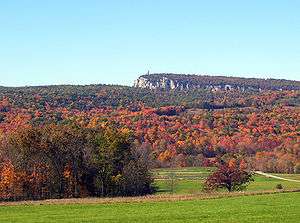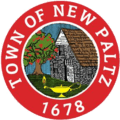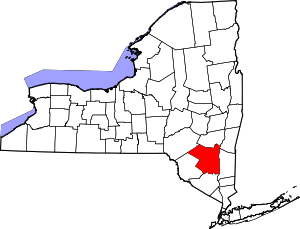New Paltz, New York
New Paltz (locally /ˈnjuː pɔːlz/) is a U.S. town in Ulster County, New York. The population was 14,003 at the 2010 census.[3] The town is located in the southeastern part of the county and is south of Kingston. New Paltz contains a village also with the name New Paltz. The town is named for Palz (IPA: [ˈpalts]), the dialect name of the Palatinate, called Pfalz (IPA: [ˈpfalts] (![]()
New Paltz, New York | |
|---|---|
Town | |
| Town of New Paltz | |
 Paltz Point view from east, a view that dominates the town | |
 Seal Wordmark | |
| Etymology: Palatine dialect pronunciation of Pfalz | |
_highlighted.svg.png) Location in Ulster County and the U.S. state of New York. | |
.svg.png) Location of New York in the United States | |
| Coordinates: 41°44′53″N 74°05′06″W | |
| Country | |
| State | |
| County | |
| Founded | 1678 |
| Government | |
| • Type | Town Hall |
| • Supervisor | Neil Bettez |
| Area | |
| • Total | 34.31 sq mi (88.85 km2) |
| • Land | 33.88 sq mi (87.74 km2) |
| • Water | 0.43 sq mi (1.12 km2) |
| Elevation | 239 ft (73 m) |
| Lowest elevation | 160 ft (50 m) |
| Population (2010) | |
| • Total | 14,003 |
| • Estimate (2016)[2] | 14,108 |
| • Density | 416.47/sq mi (160.80/km2) |
| Time zone | UTC-5 (Eastern) |
| • Summer (DST) | UTC-4 (EDT) |
| ZIP Code | 12561 |
| Area code(s) | 845 |
| FIPS code | 36-111-50562 |
| Wikimedia Commons | New Paltz, New York |
| Website | Town of New Paltz, NY |
Due to the presence of what is now the State University of New York at New Paltz, it has been a college town for over 150 years.
History
The town of New Paltz was founded in 1678 by French Huguenots by both patent from the governor and purchase from the local Esopus tribe of the Lenape people. The Huguenots were religious refugees who had immigrated via Mannheim in the German Palatinate, where they had settled after fleeing France during religious persecution. They settled in the area of the present-day village of New Paltz (on what is now known as Huguenot Street Historic District) and established their own local government.[4]
The size of the town increased with annexation from surrounding regions in 1775 and 1809. In 1842, part of New Paltz was removed to form the Town of Esopus. More of New Paltz was removed in order to form the towns of Rosendale (1844), Lloyd (1845), and Gardiner (1853).
Geography
The Wallkill River flows northward through New Paltz on its way to join the Rondout Creek, which in turn feeds into the Hudson River.
A portion of the Shawangunk Ridge is in the town.
Transportation
New Paltz is accessible by a number of different roads. Interstate 87 (the New York State Thruway) is the main thoroughfare and passes through in the eastern part and houses Exit 18 for Route 299. State routes that traverse through are Route 32, Route 208, and Route 299.
The nearest train station is about 11 miles (18 km) away, in Poughkeepsie. Both Amtrak and Metro-North trains serve Poughkeepsie. Adirondack Trailways also provides bus transportation from New Paltz into various locations across multiple states.
Education
New Paltz has 4 public schools, K-12 and is home to a college in the SUNY system.
- Duzine Elementary School (K-2)
- Lenape Elementary School (3-5)
- New Paltz Middle School (6-8)
- New Paltz High School (9-12).
- State University of New York at New Paltz
The town is also home to several private schools.
Government
The town is governed by a town council composed of four at-large members and a supervisor who serve for four years. The highway superintendent and the town clerk also serve four year terms. There is also a Village of New Paltz within the town governed by a mayor and a board of trustees.
Sister city

Notable people
- Benjamin F. Church, Milwaukee, Wisconsin pioneer
- Jay Le Fevre, former US Congress member
- John Turturro, Hollywood Actor
- Sandy Duncan, actor of Broadway theatre and television fame.
- Terry Austin, comic book Artist and Inker
- Floyd Patterson, heavyweight boxing champion.
- Paul Benenati, United States Army major general and Deputy Commander of the First United States Army
- Dana Lyons, folk music and alternative rock musician
- Charles Davis, NFL Television Commentator
- Keith Schiller, Deputy Assistant and Director of Oval Office Operations for President Donald Trump
- Andrew Yang, Founder of Venture for America and 2020 candidate for President
- Vladimir Feltsman, Distinguished Professor of Piano at the State University of New York at New Paltz
- Louis Dubois, founder of one of the earliest Huguenot colonies in the Americas.
- Abe Attell, boxing champion.
- Lewis DuBois, descendant of the original Huguenot refugees and a military commander in the Continental Army during the American Revolution.
- Mary Gordon, novelist.
- Peter Dinklage, actor.
Demographics
| Historical population | |||
|---|---|---|---|
| Census | Pop. | %± | |
| 1820 | 4,612 | — | |
| 1830 | 5,105 | 10.7% | |
| 1840 | 5,408 | 5.9% | |
| 1850 | 2,729 | −49.5% | |
| 1860 | 2,023 | −25.9% | |
| 1870 | 2,040 | 0.8% | |
| 1880 | 1,958 | −4.0% | |
| 1890 | 2,242 | 14.5% | |
| 1900 | 2,264 | 1.0% | |
| 1910 | 3,025 | 33.6% | |
| 1920 | 2,163 | −28.5% | |
| 1930 | 2,550 | 17.9% | |
| 1940 | 2,815 | 10.4% | |
| 1950 | 3,749 | 33.2% | |
| 1960 | 5,841 | 55.8% | |
| 1970 | 10,415 | 78.3% | |
| 1980 | 10,183 | −2.2% | |
| 1990 | 11,388 | 11.8% | |
| 2000 | 12,830 | 12.7% | |
| 2010 | 14,003 | 9.1% | |
| Est. 2016 | 14,108 | [2] | 0.7% |
| U.S. Decennial Census[5] | |||

As of the census[3] of 2016, there were 14,108 people, 4,455 households, and 2,347 families residing in the town. The population density was 378.4 inhabitants per square mile (146.1/km2). There were 4,679 housing units at an average density of 138.0 per square mile (53.3/km2). The racial makeup of the town was 82.16% (10,541) white, 5.99% (768) black or African American, 0.20% (25) Native American, 4.06 (520) Asian, 0.05% (6) Pacific Islander, 4.93% (632) from other races, and 2.62% (336) from two or more races. Hispanic or Latino of any race were 8.22% (1,054) of the population.
There were 4,455 households, out of which 26.0% had children under the age of 18 living with them, 40.4% were married couples living together, 9.0% had a female householder with no husband present, and 47.3% were non-families. 31.2% of all households were made up of individuals, and 8.4% had someone living alone who was 65 years of age or older. The average household size was 2.36 and the average family size was 2.99.
In the town, the population was spread out, with 16.9% under the age of 18, 31.4% from 18 to 24, 23.7% from 25 to 44, 19.0% from 45 to 64, and 9.1% who were 65 years of age or older. The median age was 26 years. For every 100 females, there were 86.6 males. For every 100 females age 18 and over, there were 83.0 males.
The median income for a household in the town was $40,542, and the median income for a family was $55,537. Males had a median income of $38,250 versus $26,629 for females. The per capita income for the town was $18,436. About 6.8% of families and 18.6% of the population were below the poverty line, including 8.9% of those under age 18 and 8.8% of those age 65 or over.
Historic places
- Minnewaska State Park
- Elting Memorial Library
- Huguenot Street Historic District
- Mohonk Mountain House
See also
References
- "2016 U.S. Gazetteer Files". United States Census Bureau. Retrieved Jul 5, 2017.
- "Population and Housing Unit Estimates". Retrieved June 9, 2017.
- "U.S. Census website". United States Census Bureau. Retrieved 2008-01-31.
- History of the Village of New Paltz Archived 2013-08-20 at the Wayback Machine, Retrieved February 27, 2013.
- "Census of Population and Housing". Census.gov. Retrieved June 4, 2015.
